
Sweet flag, Acorus gramineus and calamus: planting, growing, care
Contents
Acorus in a nutshell
- Acorus gramineus and Acorus calamus are perennial plants, easy to grow, ideal for edging water features or marshy areas
- Considered semi-submerged aquatic plants, acorus can be grown both in waterlogged planting beds and in aquatic containers on the terrace
- They grow in striking clumps, semi-evergreen, plain or variegated
- They like sunny or part-shade positions
- Hardy, robust, they thrive in heavy, moist soil and add volume to aquatic scenes
A word from our expert
Acorus, sweet-flag, also called “Japanese sweet-flag”, is an elegant perennial plant for damp banks that forms handsome upright clumps dressed with longly tapered, highly ornamental foliage. Acorus is much sought after for its variegated varieties such as Acorus gramineus ‘Variagetus’, ‘Ogon’ or Acorus gramineus ‘Argenteostriatus’.
This semi-submerged aquatic plant is also used in herbal medicine for its benefits, in particular the species Acorus calamus or “sweet flag”: its rootstocks with a liquorice scent release an active substance which, despite ancestral use, may increase cancer risks, although this remains debated.
From the miniature Acorus gramineus ‘Hakuro Nishiki’, barely 15 cm high and often used as a background plant in an aquarium, to the large Acorus calamus that can exceed 1 m in height, acorus offer many other attractions and can simply be used to adorn pond banks or in a water container on the terrace!
Like sedge, Acorus is a false grass that grows with its feet in water, that always grows in moist, even waterlogged soil, and spreads in shallow water.
Fairly cold-hardy and undemanding regarding soil type, it is easy to grow in sun or partial shade, wherever the soil remains wet, as it does not tolerate drought.
Ideal in heavy, moist, marshy soil, indispensable at edges of water, Acorus brings good volume to aquatic scenes which it brightens with its graphic foliage.
Discover our acorus plants to landscape your freshwater features, and let yourself be seduced by our selection of perennial plants for pond banks.
Description and botany
Botanical data
- Latin name Acorus
- Family Araceae
- Common name sweet flag, Japanese sweet flag, aromatic reed, calamus
- Flowering June–July
- Height 0.20 to 1.20 m
- Exposure Sun, partial shade
- Soil type moist soil
- Hardiness -5 to -15°C
Acorus, also called “Japanese sweet flag” or “aromatic reed”, is a perennial herbaceous plant of family Araceae, like arums. This aquatic plant is native to Japan, Korea and eastern Asia where it grows naturally on stream edges, in damp ditches, in shallow water and in marshy areas.
Two cultivated species are commonly encountered: Acorus calamus (sweet flag) and Acorus gramineus (grass-leaved acorus). They have produced several cultivars, notably ‘Variegatus’ and ‘Ogon’, which stand out for foliage variegated with cream or bright yellow. Acorus gramineus ‘decoratus’ and Acorus gramineus ‘Pusillus’ are much appreciated by aquarists for decorating aquaria not exceeding 15 cm in height.
Acorus develops fairly slowly from a clump of slightly running rootstocks into a handsome clump with an erect habit, slightly fan-shaped, from 15 cm up to 1.20 m in height with about 60 cm spread for Acorus calamus. Acorus gramineus shows less vigorous growth and forms more modest clumps not exceeding 30 cm in height. Over a few years the clump thickens thanks to its thin, ramified rootstocks that spread without ever becoming invasive. They tolerate immersion of up to 10–15 cm of water. They are edible and give off a strong aromatic scent reminiscent of liquorice.
Acorus is notable for its semi-evergreen foliage in mild climate, very graphic for much of the year and with a gramineous appearance. From these superficial or semi-submerged rootstocks emerge large linear, pointed leaves, erect and sword-shaped, 8 to 35 cm long, about 2 cm wide, leathery, thick, with a prominent central vein and finely undulate margins. Like long shiny, sharp ribbons, overlapping one another in a fan, they resemble leaves of yellow flag iris (Iris pseudoacorus), but when crushed emit a slight aniseed or tangerine scent. Aromatic, this foliage is also edible and will subtly flavour a salad.
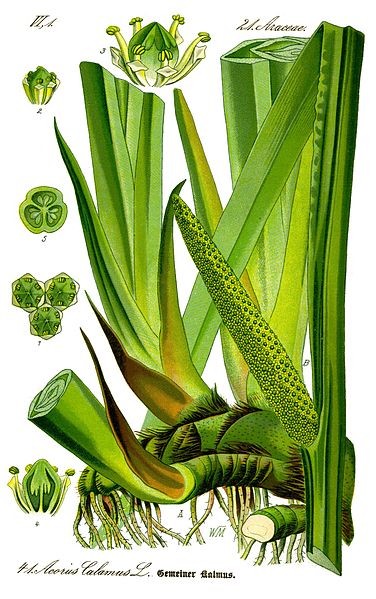
Acorus calamus – botanical illustration
Both typical species, Acorus calamus and Acorus gramineus, with beautiful glossy green foliage have produced cultivars offering sumptuously variegated and subtly striped tones of cream and yellow; chartreuse-green marginated with golden yellow in ‘Ogon’, bright green striped with cream-white in Acorus calamus ‘Variegatus’ and in Acorus gramineus ‘Variegatus’, and silver-striped in Acorus gramineus ‘Argenteostriatus’. At bud burst period, young shoots show pinkish highlights.
While this aquatic plant surprises with the brightness of its foliage, its flowering, when it occurs, is much more discreet, because Acorus only flowers if its roots are in water. Insignificant, the 6-petalled yellow-green flowers gathered in small cylindrical spikes appear in June–July and have little ornamental interest.
Acorus has variable hardiness depending on variety, but is hardier than often thought, tolerating temperatures from -5°C to -15°C, sometimes more depending on growing conditions. In cold regions, container cultivation with overwintering indoors is more appropriate.
It prefers heavy soil, permanently moist or even in shallow water, in partial shade in southern regions to protect variegated-leaved varieties, in full sun elsewhere.
Acorus is ideal on margins of a pond or pool to brighten a cool corner of the garden. It can also be used as an edge for a border or a permanently damp path and even in a trough or as an aquatic container.
The dried rootstock of Acorus calamus, or “sweet flag”, has aromatic and medicinal properties used for millennia in herbal medicine as an infusion and in phytotherapy for its digestive action.
Main species and varieties
Two species of Acorus are found in our gardens, both of which have given rise to very bright variegated foliage cultivars suited to partially shaded situations:
- Acorus calamus or “sweet flag”, aromatic and medicinal, is the tallest, reaching up to 1.20 m. Its cultivar Acorus calamus ‘Variegatus’, also called “variegated Acorus”, is more modest in size, not exceeding 1 m in height.
- Acorus gramineus, or “grass‑leaved Acorus”, is very similar to the previous species but much smaller, reaching only 20 to 30 cm in height. It is also available in variegated cultivars such as Acorus gramineus ‘Variegatus’ and Acorus gramineus ‘Ogon’.
Our favourites
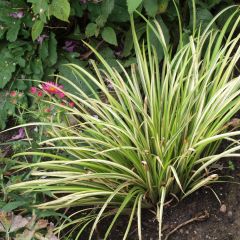
Acorus gramineus Variegatus
- Flowering time July, August
- Height at maturity 30 cm
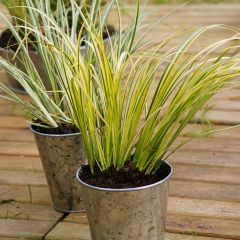
Acorus gramineus Ogon - Variegated Japanese Sweet Flag
- Flowering time July, August
- Height at maturity 40 cm
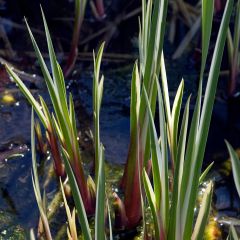
Acorus calamus Variegatus
- Flowering time July, August
- Height at maturity 50 cm
Discover other Acorus
View all →Available in 2 sizes
Available in 1 sizes
Available in 2 sizes
Available in 1 sizes
Available in 1 sizes
Available in 1 sizes
Available in 1 sizes
Planting
Where to plant Acorus or Japanese sweet-flag?
This semi-aquatic, rhizomatous perennial has a moderate hardiness and tolerates temperatures from -5°C to -15°C depending on variety, Acorus calamus being the hardiest among them.
In harsher climates it may not survive severe frosts below -10°C, so it is preferable to grow Acorus in a pot and overwinter it in a bright, frost-free room. The plant is tender during its early years but, once well established, becomes hardier.
Salt-spray tolerant, it is a good plant for seaside situations, ideal for coastal gardens.
Moist-bank plant, it favours waterlogged and part-shaded areas of the garden. Prefer a part-shaded position in hot regions to prevent scorching of variegated acorus leaves.
Acorus grows in rather acidic, rich and humus-bearing soil, moist throughout the year; it prefers clay soils. It even tolerates permanent submersion in shallow water of 10–15 cm.
Choose its site carefully as once established Acorus dislikes being moved.
Used singly or planted in groups, Acorus or Japanese sweet-flag structures space and adds relief, scale and brightness to cool, damp areas of the garden; it is indispensable at edge of a water feature. Highly architectural, it can also be used as edging for a border or path that remains permanently very wet. In a pot or large container, where soil must be kept constantly wet, it makes a mini-aquatic garden and will bring a whimsical, contemporary touch to terraces.

Acorus gramineus
When to plant Acorus or Japanese sweet-flag?
Planting Acorus is best done in spring, from March to May, once risk of frost has passed.
How to plant Acorus?
In open ground or in a pot, ensure plant never lacks water. Find the right steps to plant a perennial properly in our video!
In open ground
Space Acorus buckets about 30 cm apart and plant at around 7 plants per m² depending on mature size for good density in a bed: plant a minimum of 3 plants of the same variety. Japanese sweet-flag can be planted in soil that is not waterlogged but remains cool to moist and receives some shade.
- Loosen soil well and dig a hole 2–3 times the volume of the pot
- Place Acorus rootball in centre of hole in a mix of loam and leaf mould compost
- Backfill the hole then firm gently with the foot
- Mulch the base with organic mulch to keep soil cool and water generously at planting then very regularly to keep soil constantly moist
Planting Acorus at pond edge
Acorus is a marsh plant that can be planted on the bank of a pond, close to the water but not submerged. To prevent it becoming too invasive, plant in containers on the pond edge: the plant will then be easier to overwinter in cold climates.
- In soil enriched with organic matter, bury rootstocks about 10–15 cm deep
Planting Acorus in a pot
- Fill a non‑drilled pot or galvanised zinc tub at least 50 cm in diameter with compost for aquatic plants
- Plant the rootball directly or place it in a perforated basket for aquatic planting
- Water to keep substrate constantly moist
- Bring the pot indoors to protect from frost in autumn in cold regions

Acorus gramineus ‘Ogon’ is well suited to container growing!
Read also
10 aquatic plants, submerged or floatingCare and maintenance
Acorus is easy to grow in regions where it does not freeze severely.
This marsh plant, does not tolerate being dry: in pots or in open ground, ensure substrate is constantly waterlogged and water accordingly.
Protect the base of the plant with a good organic mulch (litter layer of dead leaves) to retain soil moisture in summer and protect its rhizomatous roots from cold in winter, especially north of the Loire, for at least the first 2–3 years.
Acorus grown in pots appreciates a supply of organic matter (such as horn meal or compost) in spring and summer. Water abundantly during growth: soil must never dry out, even in winter.
Maintenance amounts to a single cleaning of clumps at end of winter: cut leaves back to ground level when withered, wilted or completely yellow and remove spent flower spikes. Follow correct techniques by watching our advice on pruning grasses!
In regions with colder winters, overwinter Acorus in a cool, bright room, protected from frost, keeping them watered.
Every three or four years, divide the oldest clumps to rejuvenate them, because as with all perennials, plants tend to lose vigour over time.
Apart from pond snails (Lymnaeidae), freshwater gastropods common in ponds and basins, which may sometimes devour young leaves, Acorus has no pests: remove their eggs stuck under leaves and trap them with lettuce leaves placed on water, then dispose of them.
Propagation
Acorus are propagated by dividing clumps in spring. This preserves the clump and also rejuvenates it. Carry out on well-rooted clumps 3 or 4 years old.
- With a spade, lift fragments of rootstock from the periphery bearing a few leaves and buds
- Cut leaves in half
- Replant the sections of rootstock straight away into pots or in open ground in a mix of good garden soil and leaf mould
- Keep the soil constantly moist
Companion planting with sweet flag
With its elegant foliage, sometimes variegated with cream or yellow, and its very graphic silhouette, Acorus always brings lots of brightness, volume and structure to wet areas of the garden and to the edges of water features. In mild climates, it helps preserve a handsome garden even in winter with its persistent foliage.
With its semi-aquatic, grass-like appearance, it pairs with a multitude of plants and fits into all contemporary gardens, wild or naturalistic. It deserves a prime place at pond edges, in a large waterlogged border or on a contemporary terrace.
It is indispensable in aquatic scenes in a water garden alongside other perennial plants of damp banks such as astilbes, carex, garden rushes, Goat’s beard, aconites, lady’s mantles, marsh euphorbias, canes of Provence, rodgersias and Filipendula.

An idea for a planting combination on a damp bank : Pontederia cordata, Hakonechloa macra ‘Aureola’, Ligularia dentata ‘Desdemona’, Matteuccia struthiopteris and Acorus gramineus ‘Ogon’
Its slender leaves form a beautiful contrast with the broader, more supple habit of Osmundas, hostas and Euphorbia palustris.
In a damp border, surround your acorus with flowering plants with an erect habit such as marsh irises, Japanese irises, loosestrifes, Lysimachia, ligularias and candelabra primulas.
Useful Resources
- Find our Acorus varieties
- Discover our ideas for pairing Acorus
- Waterside vegetation offers a wide range for gardeners: discover our collection of perennial plants for moist to wet soils
- Get inspired by our selection of aquatic plants to enhance your water feature!
- Subscribe!
- Contents
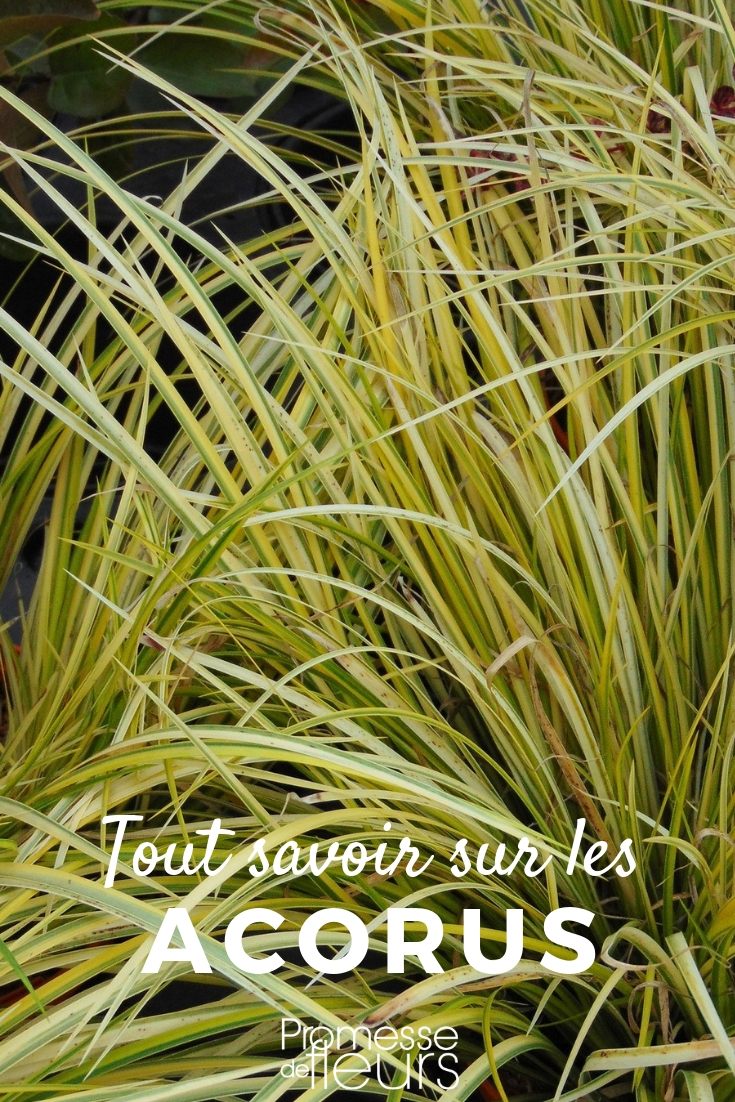



































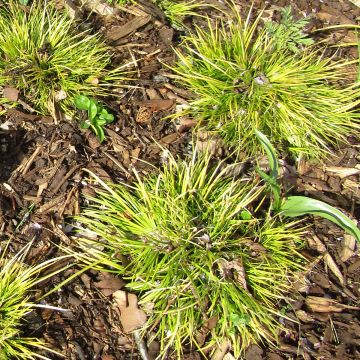
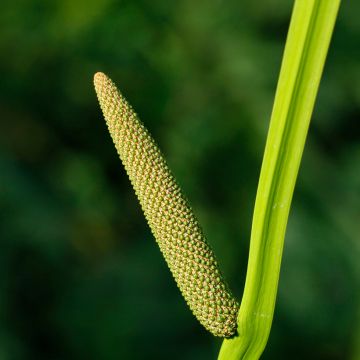
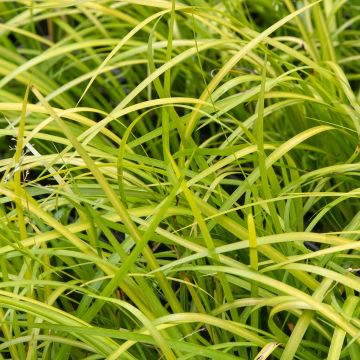

Comments